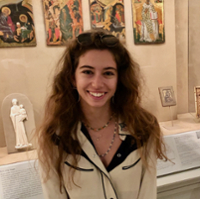
Associate Director of the Madison Art Collection and Assistant Professor of Art History
harveymx@jmu.edu
Contact Info
Pronouns: she/her
EDUCATION:
- Ph.D., (Art History), University of Cambridge
- M.A., Courtauld Institute of Art
- B.A., (Art History), University of Cambridge
AREAS OF EXPERTISE:
Medieval Mediterranean art and architecture; southern Italy; art and identity; reception; female patronage; the ‘Questione Meridionale.’
EXPERIENCE:
Dr. Harvey has taught in the Department of History of Art at the University of Cambridge as a graduate student and in 2019-20 as an Affiliated Lecturer. She was a Rome Fellow at the British School at Rome in 2020-21 and an Andrew W. Mellon Fellow at the Metropolitan Museum of Art in 2018-19.
HONORS AND AWARDS:
Dr. Harvey has received research grants and awards from the British School at Rome (2015-16 and 2020-21); the Metropolitan Museum of Art; Clare College, the University of Cambridge; Kettle’s Yard; and the Courtauld Institute of Art.
PUBLICATIONS:
‘Icon, Souvenir, Contact Relic: the Metropolitan Museum’s Virgin Eleousa Micromosaic Icon,’ Metropolitan Museum Journal, Vol. 56 (2021), 113-131.
‘Interrogating remains, destroying the past: art history and heritage conservation in southern Italy’, Immediations: the Courtauld Institute of Art Journal of Postgraduate Research, Vol. 18 (2021), available online: shorturl.at/ikotM
‘Innovation and archaisms in Raimondello del Balzo Orsini’s Santa Caterina in Galatina (c.1385-1391)’, Arte Medievale, Forthcoming.
‘From Provence to Calabria: Filippo Sangineto and Simone Martini’s St Ladislas,’ Convivium, Forthcoming.
Dr Harvey is currently working on publishing her doctoral work, a monographic study of the church of Santa Caterina at Galatina (Lecce, Italy). Her book will reconstruct how local Greek-rite and/or language communities understood and interpreted the frescoes of Santa Caterina, which were commissioned by the local signori, Catholics of Neapolitan and Provençal descent. By focusing on reception, the book will show how we can centre the experience of marginalised people in the history of art.
